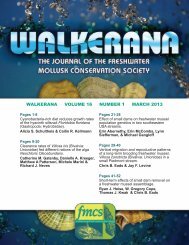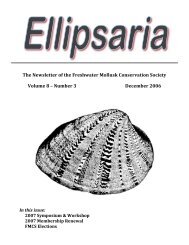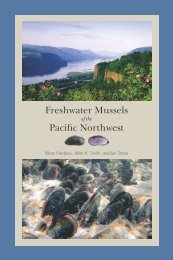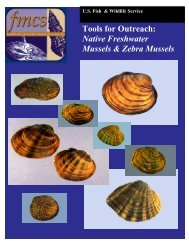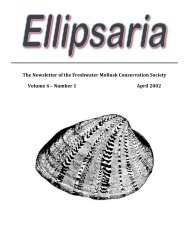Ellipsaria - Freshwater Mollusk Conservation
Ellipsaria - Freshwater Mollusk Conservation
Ellipsaria - Freshwater Mollusk Conservation
You also want an ePaper? Increase the reach of your titles
YUMPU automatically turns print PDFs into web optimized ePapers that Google loves.
References<br />
Mirarchi, R.E., J. T. Garner, M.F. Mettee, and P.E. O’Neil,<br />
eds., 2004. Alabama wildlife, volume 2. Imperiled aquatic<br />
mollusks and fishes. The University of Alabama Press,<br />
Tuscaloosa, Alabama. 255 p.<br />
Lydeard, Charles, J.T. Garner, Paul Hartfield, and J.D.<br />
Williams, 1999. <strong>Freshwater</strong> mussels in the Gulf region:<br />
Alabama. Gulf of Mexico Science, 2:125-134.<br />
Sapp, C.D., and Jacques Emplaincourt, 1975. Physiographic<br />
regions of Alabama. Geological Survey of Alabama Map<br />
168.<br />
Stansbery, D. H., 1976. Naiad mollusks, in Boschung, H.T.,<br />
ed. Endangered and Threatened Plants and Animals of<br />
Alabama. Tuscaloosa, Alabama, Alabama Museum of<br />
Natural History Bulletin, 2: 92 p.<br />
Williams, J.D., A.E. Bogan, and J.T. Garner. 2008. The<br />
<strong>Freshwater</strong> Mussels of Alabama and the Mobile Basin of<br />
Georgia, Mississippi and Tennessee. The University of<br />
Alabama Press, Tuscaloosa, Alabama. 908 p.<br />
Williams, J.D., M.L. Warren, Jr., K.S. Cummings, J.L. Harris,<br />
and R.J. Neves, 1993. <strong>Conservation</strong> status of freshwater<br />
mussels of the United States and Canada. Fisheries 18:6-9.<br />
Modeling the Response of Imperiled<br />
<strong>Freshwater</strong> Mussels to Anthropogenically<br />
Induced Changes in Water Temperature,<br />
Habitat, and Flow in Streams of the<br />
Southeastern and Central United States<br />
<strong>Freshwater</strong> mussels are in serious global decline and urgently<br />
need protection and conservation. Declines in the abundance<br />
and diversity of North American mussels have been attributed<br />
to a wide array of human activities that cause pollution, waterquality<br />
degradation, and habitat destruction, and recent<br />
findings suggest that many species are living close to their<br />
upper thermal tolerances. This project will combine the<br />
expertise and resources of multiple scientists, agencies, and<br />
universities and build on past findings. The primary objective<br />
is to use newly developed mussel vulnerability and risk<br />
threshold data in downscaled watershed and instream regional<br />
models to allow federal and state natural resource managers to<br />
forecast species responses to climate change over the next 30-<br />
50 years and to develop adaptation strategies to mitigate the<br />
adverse effects. Secondary objectives will be to refine these<br />
models and to generate new models with empirical data<br />
produced from integrated laboratory and field studies of<br />
mussel temperature sensitivities in water and sediment, and<br />
instream flow and habitat assessments for mussels. Each<br />
objective specifically addresses priority needs of federal and<br />
state management partners. The research combines laboratory,<br />
field, and modeling approaches utilizing existing data and<br />
gathering new empirical information; spans broad spatial,<br />
temporal, and organizational scales; supports the higher<br />
education of future natural resource professionals; and<br />
contributes to the science and conservation of the most<br />
imperiled fauna in the world as affected by climate change.<br />
For more information contact:<br />
W. Gregory Cope, NC State University, Department of<br />
Environmental and Molecular Toxicology, 919-515-5296,<br />
greg_cope@ncsu.edu or<br />
8<br />
Teresa J. Newton, USGS, Upper Midwest Environmental<br />
Sciences Center, 608-781-6217, tnewton@usgs.gov<br />
The Aquarium Trade Continues to Endanger<br />
the <strong>Freshwater</strong> Mollusc Fauna in Israel<br />
Henk K. Mienis<br />
National Collections of Natural History, Dept. Zoology,<br />
Tel Aviv University, IL-69978 Tel Aviv, Israel, and<br />
National Natural History Collections, Berman Building,<br />
Hebrew University, IL-91904 Jerusalem, Israel<br />
mienis@netzer.org.il<br />
In so called pet-shops the sale of aquarium attributes has<br />
always played an important part in the overall income. To<br />
these attributes belong of course not only all the necessary<br />
items like aquaria in all sizes and forms, water pumps, filters,<br />
heating systems (where necessary), but also an extremely rich<br />
variety of fish, aquatic plants and usually some snails in order<br />
to combat excessive algae growth.<br />
The snails encountered in most aquaria in Israel belonged<br />
usually to such species like Planorbella duryi (Wetherby,<br />
1879) (Planorbidae), Pseudosuccinea columella (Say, 1817)<br />
(Lymnaeidae), Haitia acuta (Draparnaud, 1805) (Physidae)<br />
and Melanoides tuberculata (Müller, 1774) (Thiaridae).<br />
Except for Melanoides tuberculata, all are non-native species,<br />
which have found their way to natural aquatic habitats<br />
throughout Israel a long time ago.<br />
In the last 10-15 years the number of exotic freshwater snails<br />
offered for sale in local pet shops has increased considerably.<br />
They range from an assortment of fist sized species of<br />
Pomacea from the Americas to much smaller additional<br />
species of the families Planorbidae, Lymnaeidae, and<br />
Physidae. Some of these species can be found here and there<br />
now in natural habitats and have to be looked upon as serious<br />
competitors of native species (Mienis, 2009).<br />
Most recently also other species of Thiaridae: Tarebia<br />
granifera (Lamarck, 1822) and Thiara scabra (Müller, 1774),<br />
both from the tropics, went on sale in Israel. Like the local<br />
Melanoides tuberculata they do extremely well in aquaria and<br />
turn soon into a nuisance. Since aquarium keepers are usually<br />
also animal lovers, excess snails are not killed but given away<br />
to other aquarium lovers or simply released in a nearby spring,<br />
stream, pond or lake. The latter event has recently happened in<br />
Israel with both Tarebia and Thiara. Within a very short time<br />
they managed to establish large populations in the Bet She'an<br />
Valley and Thiara scabra has even turned into the most<br />
common species in the Sea of Galilee, Israel's major source for<br />
drinking water (Mienis, 2010; Mienis & Mienis, 2008)!<br />
In spite of warnings given to the proper authorities about the<br />
danger of allowing the almost free import of freshwater snails<br />
for the aquarium trade, new species continue to arrive in the<br />
local shops: Marisa cornuarietis (Linnaeus, 1758), Vittina<br />
natalensis (Reeve, 1845) and a still unidentified Clithon<br />
species. How long will it last until we find the first specimens<br />
of such new arrivals in the wild?



